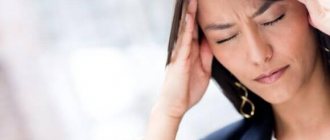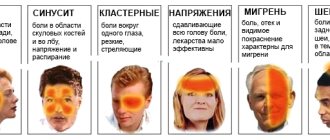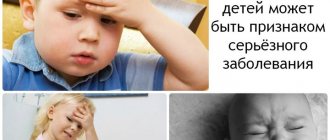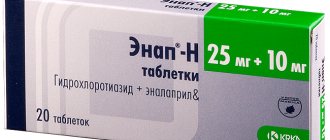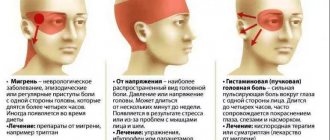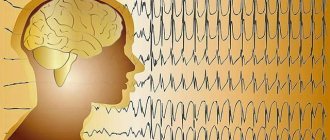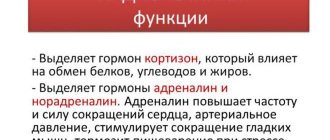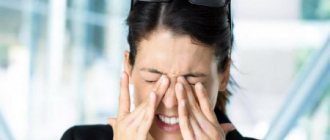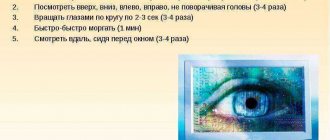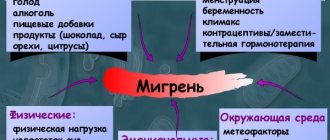If you have a headache, it causes a lot of discomfort. A person practically cannot live or work normally. Rest also becomes torture. If your neck and head hurt, or you feel nauseous, you should immediately consult a doctor.
Neck and head hurt
This pathological condition indicates the presence of a serious disease.
Causes of pain in the neck and back of the head
Pain in the neck and head is caused by various reasons: vascular pathologies, degenerative dystrophic changes in the tissues of the spinal column, inflammation, spasms, muscle strain, etc. We suggest you understand all the existing factors and gradually eliminate them from your life.
Potential causes of neck and head pain may include:
- degenerative processes in intervertebral cartilaginous discs (their subsidence, prolapse of hernia);
- destruction of intervertebral joints (deforming spondyloarthrosis);
- inflammation of the muscles in the neck area of the collar zone (myositis) and their spasms;
- fibromyalgic pain syndrome;
- curvature of the spinal column;
- compression and inflammation of the radicular nerves and nerve plexuses;
- posterior vertebral artery syndrome;
- destruction of uncovertebral processes;
- displacement of the vertebral bodies by the type of antelisthesis and retrolisthesis;
- subluxation of the first cervical vertebra;
- injuries in the neck (stretching and rupture of ligament and tendon fibers, formation of hematomas, cracks and fractures of bone tissue).
Also, pain in the neck and head can be provoked by rheumatic processes: ankylosing spondylitis, systemic lupus erythematosus, scleroderma, rheumatic arthritis.
Provocative factors that cause pain in the back of the head and neck:
- excess body weight, which greatly increases the shock-absorbing and physical load on the spinal column;
- maintaining a sedentary lifestyle, which disrupts all metabolic processes and diffuse nutrition of the cartilage tissue of the intervertebral discs;
- improper organization of the sleeping and working space, as a result of which increased tension begins to be exerted on the neck and collar area;
- violation of posture and curvature of the spinal column in the lumbar and thoracic regions;
- incorrect foot placement – leads to uneven distribution of load during walking and running;
- prolonged static tension of the muscles of the neck and collar area during work;
- falls, bruises, accidents.
Negative factors should be eliminated by giving up bad habits, such as smoking, drinking alcohol, eating fatty foods, etc. Try to drink more clean drinking water, spend more time in the fresh air, engage in physical exercise, etc.
When to see a doctor
Make an appointment with your doctor if:
- You begin to experience new headaches that last more than a few days
- your headaches interfere with your normal activities
- pain accompanied by tenderness
- You are experiencing any new changes in headache patterns
- If you develop a severe headache that is worse than ever, or if your headaches gradually get worse, you should make an appointment as soon as possible.
- If your pain becomes unbearable, go to the emergency room.
There are some symptoms that indicate an emergency. If you experience a headache along with any of the following symptoms, get emergency medical help:
- sudden changes in your personality, including unusual mood swings or agitation
- fever, stiff neck, confusion, and decreased alertness to the point that you have difficulty concentrating on a conversation
- blurred vision, slurred speech, weakness (including weakness on one side of the face), and numbness anywhere on the body
- severe headaches after a blow to the head
- headaches that come on very suddenly, especially if they wake you up
Author: Alena Kyupeli
Severe pain in the back of the head and neck
Any pain in the neck and head requires a careful approach to differential diagnosis. Most often at a young age it is pain in the muscles of the neck and head, which are not ready for the loads that are placed on them.
Lack of training of the muscle fiber, prolonged static tension, disruption of the processes of microcirculation of blood and lymphatic fluid - all this provokes the development of foci of ischemic reaction in the thickness of the muscle. This manifests itself as pain and muscle strain. Against the background of prolonged muscle spasm, the blood supply to larger areas of soft tissue is disrupted.
Quite severe pain in the neck and head can be a consequence of the development of fibromyalgia syndrome. With this pathology, there is a mismatch in the functioning of the autonomic nervous system. Different parts of the muscle begin to contract in a chaotic manner. This causes excess tension and spasm of the bloodstream. The fibrous membrane of the muscle becomes inflamed and acute pain occurs.
Severe pain in the back of the head and neck can be the result of a disruption in the blood supply to the posterior parts of the brain. In the area of 6-7 cervical vertebrae, the posterior vertebral arteries emerge from the chest. They are directed through the uncovertebral canal to the foramen ovale in the occipital bone of the skull. There they pass into the intracranial channel and, branching, provide blood supply to the tissues.
When the patency of the posterior vertebral arteries is impaired, reflex muscle tension occurs in the neck and collar area. In this way, the body tries to restore the impaired blood supply to the brain tissue. Muscle tension compresses small nerve endings. Acute pain occurs.
Symptomatic treatment
As a rule, treatment of pain in the back of the head and neck is carried out comprehensively and includes the use of painkillers, NSAIDs, muscle relaxants, various methods of physiotherapy, massage, and folk remedies can be used.
Medicines
Medicines are prescribed to relieve pain, spasms, and improve blood circulation. They can be used both in the form of tablets and in the form of injections or ointments.
Examples of the most popular painkillers and NSAIDs (non-steroidal anti-inflammatory drugs): Nurofen, Diclofenac, Nise.
Physiotherapy
After pain symptoms are relieved, patients are often prescribed a series of physiotherapeutic procedures that not only eliminate the symptoms, but also affect the cause of the discomfort.
The following methods are used:
- magnetotherapy,
- ultrasound,
- general or acupressure massage,
- manual therapy or osteopathy sessions,
- physiotherapy,
- acupuncture.
All of the above therapy methods improve blood circulation, restore muscle and tissue function, accelerate regeneration, and improve the patient’s general physical condition.
Folk remedies
The use of folk remedies can be a good help along with painkillers and physiotherapeutic methods. After consulting a specialist and identifying the exact cause of the disease, alternative methods can be used.
Examples of folk recipes:
- mint-chamomile decoction: 1 tablespoon of mint, 1 tablespoon of chamomile, pour 200 ml of hot water, heat in a water bath for 20 minutes, apply 2 times a day. This decoction perfectly relieves inflammation and reduces pain,
- sea buckthorn compress: wrap 100 g of fresh berries in a warm bandage and apply to the sore spot overnight. The compress will reduce pain and inflammation,
- oil ointment: mix 1 drop of eucalyptus essential oil with 1 teaspoon of peach oil, rub into the skin several times a day. The ointment will relieve pain and enhance tissue regeneration.
Note. The use of vitamins and mineral complexes based on omega acids allows you to speed up the healing process, has a beneficial effect on all circulatory systems, and saturates the body with immunostimulants and antioxidants.
Sharp shooting pain in the neck and head
Sharp pain in the neck and head is in most cases a clinical symptom of osteochondrosis. When the height of the intervertebral discs changes, pressure begins to be exerted on the surrounding soft tissue. To prevent this negative impact, the mechanism of development of the inflammatory process is triggered. In this case, blood and lymphatic fluid are drawn into the area of pathological changes, and infiltrative swelling of the soft tissue occurs. All small nerve endings are compressed. This is what causes sharp pain in the neck and head at the stage of intervertebral disc protrusion.
Shooting pains in the neck and head indicate further progress of osteochondrosis. With pronounced protrusion (decrease in the height of the intervertebral disc), it protrudes beyond the adjacent vertebral bodies. The disc begins to put pressure on the radicular nerve or paired cranial nerves emerging from the foramen ovale. If the nerve that is responsible for the innervation of the scalp is affected, then a lumbago occurs in the head. If the nerve fiber responsible for the innervation of the collar zone is affected, then the lumbago is felt right here.
If the nerve plexus is damaged, shooting pains may be present simultaneously in the head, neck, shoulders, collar area, etc.
Folk recipes
You should immediately pay attention to the fact that the root cause of the disease may remain intact (until you visit a doctor). Prescriptions can only relieve pain during acute attacks, and their use does not mean that medical care and modern diagnostics are not needed.
- A way to relieve headaches, quite funny, but effective: press your forehead against the window glass. Oddly enough, it really relieves the pain, or at least part of it.
- A compress on the forehead from a fresh cabbage leaf relieves pain; the leaves need to be changed.
- A rag generously moistened with kerosene (!) is applied to the painful area, then the compress must be insulated and kept for at least 2 hours.
- Potatoes are grated on a fine grater, mixed with an equal amount of honey, applied to the neck, shoulders, and insulated. You need to keep the compress for 2 hours. Additional effects of this compress include improving the condition of the skin. After removing the compress, wipe the skin. Carry out several procedures.
Without the advice of a doctor, it is better to avoid radical recipes with strong ingredients that irritate the skin. Without knowing the exact diagnosis and the true causes of pain, you can harm yourself.
Constant aching and throbbing pain in the neck and head
Constant pain in the head and neck can be a sign of more than just osteochondrosis. They often occur with pathologies of the vascular bed. Therefore, the patient is prescribed an ultrasound scan of the vessels of the brain and neck.
Aching pain in the neck and head is a reason to consult a doctor in a timely manner. Many diseases can manifest themselves in this way. It is very difficult to diagnose yourself, since this requires a number of special examinations.
Throbbing pain in the head and neck can be a clinical symptom of arterial hypertension. This disease develops against the background of atherosclerosis and renal pathologies. It provokes a sharp increase in blood pressure, which can result in stroke, rupture of a blood vessel, dilatation of the fundus vessels, etc.
Treatment for head and neck pain
Treatment of pain in the head and neck should begin with a differential diagnosis. At the patient’s initial visit, the doctor examines him and makes a preliminary diagnosis. Then an x-ray of the cervical spine is prescribed. Based on its results, it is possible to exclude the possibility of growth of bone growths (osteophytes), destruction of uncovertebral processes, decrease in the height of intervertebral discs, etc. If there are difficulties in making an accurate diagnosis, ultrasound examination of the blood vessels of the neck and head is prescribed. With this examination, it is possible to exclude posterior vertebral artery syndrome, vertebrobasilar circulatory failure syndrome and a number of other serious pathologies. MRI and CT are also used in diagnosis.
Acute pain in the neck and head, which is provoked by degenerative dystrophic processes in the tissues of the spinal column, begins to be treated with a manual traction procedure. As a result of this effect, the intervertebral spaces increase and compression is removed from the nerve fiber. The patient experiences significant pain relief.
Then, depending on the diagnosis, an individual course of treatment is developed for the patient. The following types of treatment procedures can be used:
- osteopathy to improve the processes of microcirculation of blood and lymphatic fluid in the lesion;
- massage to relieve excess muscle tension and restore blood supply;
- therapeutic exercises and kinesiotherapy to restore diffuse nutrition of cartilage tissue and strengthen the muscular frame of the neck and collar area;
- physiotherapy, reflexology and much more.
If you need treatment for neck and head pain, then you can make an appointment for a free appointment with a vertebrologist at our manual therapy clinic in Moscow right now. Fill out the doctor appointment form and our administrator will contact you.
Diagnostics
If you feel the symptoms described above, a person should immediately consult a therapist or traumatologist (if you suffered a head or neck injury the day before). After preliminary diagnosis, these specialists can refer you to a neurologist or oncologist.
Diagnosis consists of interviewing the patient and studying his medical history, after which the doctor refers to MTR of the cervical spine , radiography or Doppler ultrasound . You can get by with one study, but it is best to use all possible diagnostic methods - this will help to accurately determine the type of disease, its location and the degree of manifestation. This information will help you choose the most effective means to eliminate the disease.


